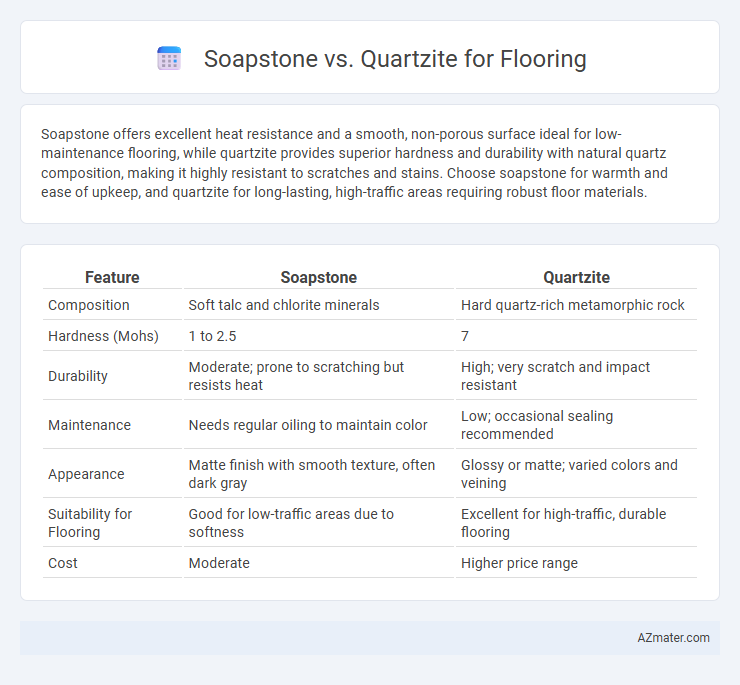Soapstone offers excellent heat resistance and a smooth, non-porous surface ideal for low-maintenance flooring, while quartzite provides superior hardness and durability with natural quartz composition, making it highly resistant to scratches and stains. Choose soapstone for warmth and ease of upkeep, and quartzite for long-lasting, high-traffic areas requiring robust floor materials.
Table of Comparison
| Feature | Soapstone | Quartzite |
|---|---|---|
| Composition | Soft talc and chlorite minerals | Hard quartz-rich metamorphic rock |
| Hardness (Mohs) | 1 to 2.5 | 7 |
| Durability | Moderate; prone to scratching but resists heat | High; very scratch and impact resistant |
| Maintenance | Needs regular oiling to maintain color | Low; occasional sealing recommended |
| Appearance | Matte finish with smooth texture, often dark gray | Glossy or matte; varied colors and veining |
| Suitability for Flooring | Good for low-traffic areas due to softness | Excellent for high-traffic, durable flooring |
| Cost | Moderate | Higher price range |
Introduction to Soapstone and Quartzite Flooring
Soapstone flooring features a smooth, non-porous surface composed primarily of talc, offering natural resistance to stains, heat, and moisture, making it ideal for kitchens and bathrooms. Quartzite flooring, formed from hardened sandstone through metamorphism, boasts exceptional durability, scratch resistance, and a striking crystalline appearance that mimics marble. Both materials provide unique aesthetic and functional benefits, with soapstone delivering a softer, warmer feel and quartzite offering superior hardness and a variety of color options.
Key Characteristics of Soapstone Flooring
Soapstone flooring offers exceptional durability, resistance to stains, and natural heat retention, making it ideal for kitchens and high-traffic areas. Its smooth, matte surface features unique veining and can darken over time, adding to its character and aesthetic appeal. Low maintenance and non-porous qualities allow soapstone to resist moisture and bacterial growth, ensuring a hygienic flooring option.
Distinctive Features of Quartzite Flooring
Quartzite flooring is highly durable, offering exceptional hardness that surpasses many natural stones, making it resistant to scratches and heavy foot traffic. Its distinctive crystalline texture and vibrant, varied color range from white and grey to pink and red provide a unique aesthetic appeal ideal for both contemporary and traditional interior designs. Quartzite's non-porous nature ensures low maintenance and high stain resistance, contributing to its popularity as a practical and visually striking flooring option.
Durability Comparison: Soapstone vs Quartzite
Quartzite offers exceptional durability for flooring due to its natural hardness and resistance to scratches, heat, and heavy foot traffic, making it ideal for high-traffic areas. Soapstone, while softer and more prone to dents and scratches, excels in resistance to stains and chemical damage, requiring less maintenance to preserve its rich, matte finish. Choosing between the two depends on prioritizing scratch resistance and hardness (Quartzite) versus chemical resistance and ease of repair (Soapstone) for your flooring needs.
Appearance and Aesthetic Appeal
Soapstone flooring offers a smooth, matte finish with subtle veining, creating a warm and rustic ambiance ideal for traditional and cozy interiors. Quartzite flooring features a glossy, crystalline surface with vibrant, natural patterns that enhance modern and sophisticated spaces through its striking visual depth. Both materials provide unique aesthetic appeals, with soapstone emphasizing understated elegance and quartzite showcasing bold, dynamic beauty.
Maintenance Requirements for Each Material
Soapstone flooring requires minimal maintenance, as it is non-porous and resists stains and liquids without needing sealants, but it benefits from occasional oiling to enhance its natural patina and prevent surface dryness. Quartzite flooring demands regular sealing to protect against stains and moisture due to its porous nature, along with routine cleaning using pH-neutral products to avoid etching or dulling the surface. Both materials offer durability, but soapstone's ease of upkeep makes it ideal for low-maintenance flooring, while quartzite requires more diligent care to maintain its polished appearance.
Cost Analysis: Soapstone vs Quartzite Flooring
Soapstone flooring typically costs between $15 and $30 per square foot, making it a more budget-friendly option compared to quartzite, which ranges from $20 to $60 per square foot due to its higher durability and aesthetic appeal. Installation costs for both materials vary, but quartzite often requires specialized cutting and sealing, increasing overall expenses. Long-term maintenance costs of soapstone are lower because of its natural resistance to stains and scratches, whereas quartzite may demand more frequent sealing to prevent damage.
Suitability for Different Spaces
Soapstone's natural resistance to heat and moisture makes it ideal for kitchens and bathrooms, providing a non-porous, easy-to-clean surface that withstands humidity. Quartzite offers superior hardness and durability, making it suitable for high-traffic areas like hallways and living rooms where scratch resistance is crucial. Both materials deliver unique aesthetic appeal, but soapstone's warmth contrasts with quartzite's bright, sparkling finish, influencing their suitability depending on design preferences and functional needs.
Environmental Impact and Sustainability
Soapstone flooring offers superior sustainability due to its natural, non-toxic composition and minimal processing requirements, resulting in a lower carbon footprint compared to quartzite. Quartzite extraction and finishing involve higher energy consumption and chemical treatments, which can increase environmental impact. Choosing soapstone supports eco-friendly building practices by reducing resource depletion and promoting durability with less maintenance over time.
Final Verdict: Choosing the Best Option for Your Floor
Soapstone offers exceptional durability and resistance to heat and stains, making it ideal for high-traffic areas and homes with heavy use. Quartzite boasts superior hardness and a more diverse color range, providing a sleek, elegant appearance that withstands scratches and wear over time. For floors requiring long-lasting strength and aesthetic versatility, quartzite is often the preferred choice, while soapstone suits those seeking a softer, natural feel with excellent maintenance properties.

Infographic: Soapstone vs Quartzite for Flooring
 azmater.com
azmater.com